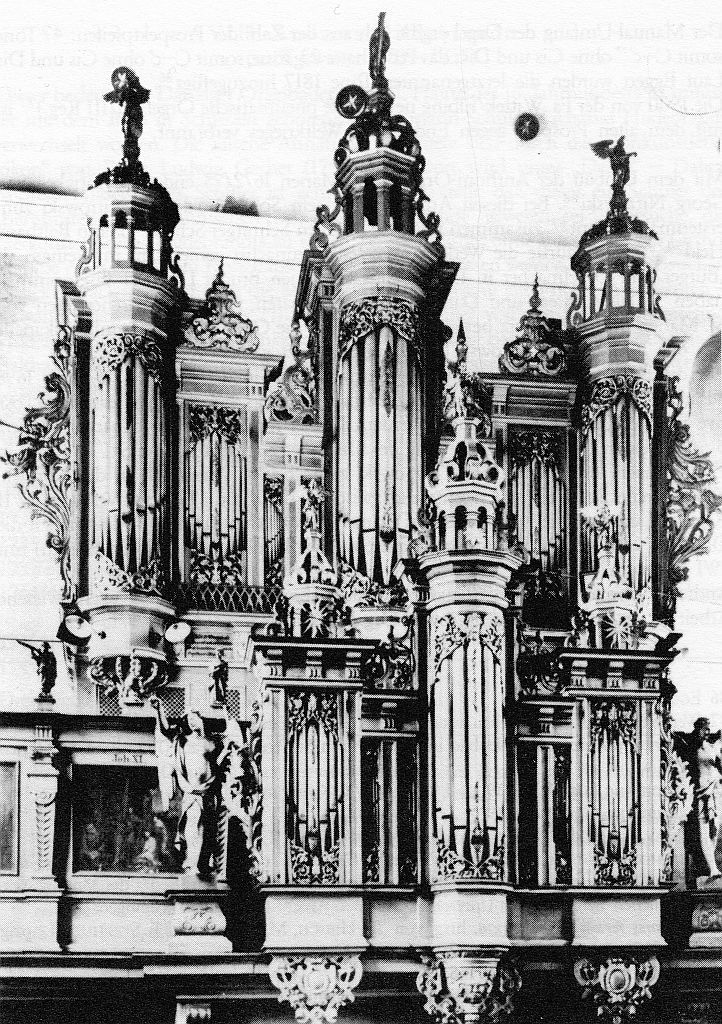Ausführliche Beschreibung der vorgewählten Orgel

Gdańsk, Polska (Województwo Pomorskie) - Kościół św. Bartłomieja (Bartholomäuskirche)
Gemeinde: Gdańsk
Adresse: Zaułek Św. Bartłomieja, Gdańsk
Beschreibung nr.: 2058403.
Gebaut von: Merten Friese (1620)
Destroyed (1940)
Technische Daten
Disposition
Haupt Manual: Bordun 16', Principal 8', Hollflöt 8', Spiel Flöt 8', Salicinal 8', Quintadena 8', Octava 4', Quinta 3', Quindecima 2', Mixtur 2 fach, Dulcian 16'.
Rück Positiv: Principal 8', Flöt 8', Octava 4', Salicinal 4', Quinta 3', Quindecima 2', Waldflöt 2', Mixtur 3 fach, Trompet 8', Halber Zinck 4'.
Brust: Octava 8', Principal 4', Quintadöna 4', Flöt 2', Regal 8'.
Pedal: Subbaß 16', Octava 8', Hollflöt 8', Salicinal 8', Supper Octava 4', Quintadöna 4', Mixtur 6 fach (4'), Posaune 16', Trompet 8', Cornetten 2'.
Sonstige Register: 2 Cimbelsterne, Paucke.
Nebenregister und Spielhilfen: Tremulant.

Gdańsk, Polska (Województwo Pomorskie) - Kościół św. Bartłomieja (Bartholomäuskirche)
Gemeinde: Gdańsk
Adresse: Zaułek Św. Bartłomieja, Gdańsk
Beschreibung nr.: 2058403.
Gebaut von: Merten Friese (1620)
Destroyed (1940)
| Jahr | Orgelbauer | Opus | Aktivität | 1620 | Merten Friese | Neubau | 1660 | Georg Nitrowski | Vergrößerung | 1763 | Friedrich Rudolf Dalitz | Restaurierung | 1899 | Max Terletzki | Neubau im alten Gehäuse |
- The Bartholomäuskirche in Gdańsk was given a new organ by Merten Friese in 1620. Georg Nitrowski expanded the instrument with pedal towers in 1658-1660. Friedrich Rudolf Dalitz worked on the organ in 1763. He replaced the two side doors of the positive and the pedal towers with wood carvings.
- In 1899 Max Terletzki built a new organ with 41 stops on three manuals in the historic organ cases. The old organ, which was more than two hundred years old, was "worn out." The organ was given an electric wind motor that was modern for that time. It was to be delivered in the winter of 1899/1900.
- The church building was severely damaged during bombing. The organ has been lost. The church was rebuilt after the war and put into use as a Jesuit church. Since 1997, the building is been the cathedral of the Greek Orthodox community.
- Mentioned is the specification according to Niedt-Mattheson's publication from 1721.
Technische Daten
| Anzahl Register pro Manual | |
| - Haupt Manual | 11 |
| - Rück Positiv | 10 |
| - Brust | 5 |
| - Pedal | 10 |
| Gesamtzahl der Stimmen | 36 |
| Tastentraktur | Mechanical |
| Registertraktur | Mechanical |
| Windlade(n) | Slider chests |
Disposition
Haupt Manual: Bordun 16', Principal 8', Hollflöt 8', Spiel Flöt 8', Salicinal 8', Quintadena 8', Octava 4', Quinta 3', Quindecima 2', Mixtur 2 fach, Dulcian 16'.
Rück Positiv: Principal 8', Flöt 8', Octava 4', Salicinal 4', Quinta 3', Quindecima 2', Waldflöt 2', Mixtur 3 fach, Trompet 8', Halber Zinck 4'.
Brust: Octava 8', Principal 4', Quintadöna 4', Flöt 2', Regal 8'.
Pedal: Subbaß 16', Octava 8', Hollflöt 8', Salicinal 8', Supper Octava 4', Quintadöna 4', Mixtur 6 fach (4'), Posaune 16', Trompet 8', Cornetten 2'.
Sonstige Register: 2 Cimbelsterne, Paucke.
Nebenregister und Spielhilfen: Tremulant.
| Literatur |
|
